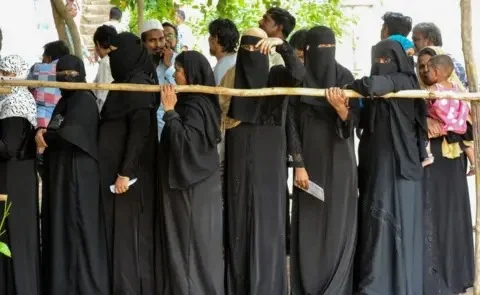Surging Muslim voter turnout ignites pre-election political analysis and debates of ‘anti incumbency’ factor
Abdullah Salam
NEW DELHI – In the ongoing Lok Sabha elections, constituencies with a substantial Muslim voter bases are witnessing a surge in turnout, sparking discussions on potential political implications and ‘anti incumbency’ factor. While overall voter enthusiasm appears subdued, there is notable energy among first-time voters, particularly among the youth. However, the Muslim electorate stands out for its heightened awareness and active engagement in the electoral process.
The Election Commission of India has expressed concern over the declining turnout, prompting observations from political experts. Shankar Sharan, a political science expert, noted that when political parties prematurely claim victory and project seat figures, some voters might feel disenchanted, potentially leading to apathy towards voting. He points out that while low voter turnout is often considered normal in many democratic nations, a significant increase in turnout can signify public discontent. In contrast to European countries, where ruling leaders fear low voter turnout, in India, an uptick in voting rates may indicate underlying public grievances.
Reports from polling stations in Lok Sabha constituencies with sizable Muslim populations reveal long queues and robust voter participation. These trends are particularly evident in regions such as Saharanpur in Uttar Pradesh, Dhubri in Assam, and Murshidabad in West Bengal, all of which have a high concentration of Muslim voters. This pattern of heightened voter engagement is not unprecedented, as previous elections have also witnessed strong turnout in Muslim-dominated seats, indicating the community’s conscientious approach to voting.
Statistics from the ongoing elections underscored the significant voter turnout in Muslim-dominated constituencies. In Dhubri, Assam, voter turnout reached an impressive 92 per cent, while other constituencies like Naugong, Barpeta, and Kishanganj also reported high voting rates ranging from 62 to 85 percent. Similarly, seats in Uttar Pradesh and West Bengal, including Saharanpur, Sambhal, and Murshidabad, witnessed substantial voter participation, reflecting the community’s proactive involvement in the electoral process.
Comparisons with previous elections reveal a consistent trend of increased voter turnout in Muslim-dominated seats. In 2014, when Prime Minister Narendra Modi contested for the first time, there was a notable uptick in voter participation across the country, resulting in a record-high turnout of 66.40 percent. This trend continued in the 2019 elections, with voter turnout reaching 67.1 percent nationally. Notably, constituencies like Dhubri in Assam consistently record high turnout rates, indicative of sustained civic engagement within Muslim-majority areas.
The significance of Muslim voters extends beyond individual constituencies, particularly in states like Uttar Pradesh and Bihar. In Uttar Pradesh, where Muslims constitute approximately 20 percent of the population, several constituencies have a substantial Muslim electorate, with some seats boasting 40 to 50 percent Muslim voters. Constituencies such as Kairana, Muzaffarnagar, and Saharanpur have witnessed increased voter participation, with Muslim voters playing a decisive role in the electoral outcome. Similarly, in Bihar, where Muslims make up around 18 percent of the population, constituencies like Kishanganj, Katihar, Araria, and Purnia have seen voter turnout rates exceeding 61 percent, underscoring the community’s electoral significance.
The surge in voter turnout in Muslim-dominated Lok Sabha seats has reignited discussions about the political landscape and potential electoral outcomes. As political parties strategize to secure support from diverse voter demographics, the proactive participation of Muslim voters signals their growing influence and underscores the importance of addressing their concerns and aspirations in the electoral arena. With several phases of voting still ahead, the dynamics of voter turnout and its implications for political outcomes remain a subject of keen observation and analysis.

